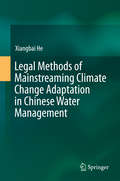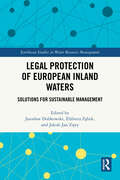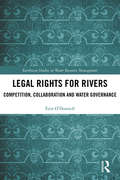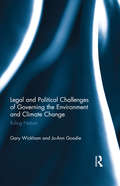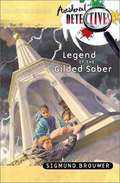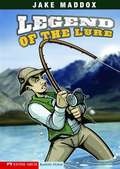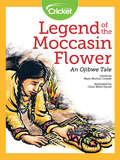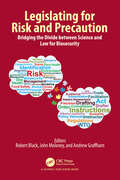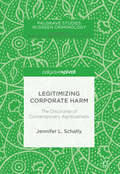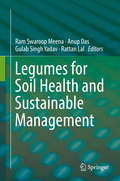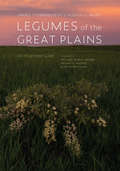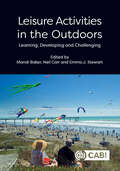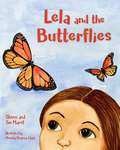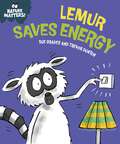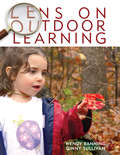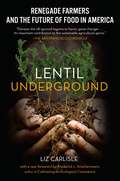- Table View
- List View
Legal Liabilities in Safety and Loss Prevention: A Practical Guide, Third Edition (Occupational Safety & Health Guide Series)
by Thomas D. SchneidThe goal of every safety professional and safety program is to be proactive and to identify problems while complying within safety guidelines. This book clarifies basic questions about legal liability, how to minimize, prevent, and identify legal risks. Appendices, case studies, and sample forms are included in this resource. The whole book will be revised due to the laws and regulations in the workplace changing. This revised edition will address all of the changes in the laws as well as providing guidance on how to achieve and maintain compliance. Features Covers methods to achieve and maintain compliance Includes new standards and regulations Discusses defense, rights, and responsibilities Provides a guide to professionals who are unfamiliar with reviewing, analyzing, and briefing a court decision Offers a new chapter on environmental and labor
Legal Methods of Mainstreaming Climate Change Adaptation in Chinese Water Management
by Xiangbai HeThis book addresses why, whether and how the existing legal framework on water management in China could make climate change adaptation a mainstream issue. The book uses a table to illustrate the distinctions and similarities between IWRM and water-centered adaptation to analyze the possibilities of mainstreaming adaptation. The new water-planning processes and EIA are also illustrated in the form of figures showing the differences after factoring in adaptation considerations. Interviews with water managers to obtain their perception and attitudes towards climate change adaptation offer new perspectives for readers. The adaptation- mainstreaming approach, which finds a way to balance various interests and tasks, will arouse the interests of those readers who argue that climate change is only one of the issues challenging water management, and that poverty reduction, environmental protection and living standard improvement are even more important. Readers will also be interested to discover that the adaptation mainstreaming approach could be applied in water management institutions such as water planning and EIA. In addition, the book offers a clear explanation of the challenges of adaptation to the existing water-related legal framework from a theoretical perspective, and provides theoretical and practical recommendations.
Legal Pathways to Deep Decarbonization in the United States
by Michael B. Gerrard; John C. DernbachLegal Pathways to Deep Decarbonization in the United States provides a “legal playbook” for deep decarbonization in the United States, identifying well over 1,000 legal options for enabling the United States to address one of the greatest problems facing this country and the rest of humanity. <p><p> The book is based on two reports by the Deep Decarbonization Pathways Project (DDPP) that explain technical and policy pathways for reducing U.S. greenhouse gas emissions by at least 80% from 1990 levels by 2050. This 80x50 target and similarly aggressive carbon abatement goals are often referred to as deep decarbonization, distinguished because it requires systemic changes to the energy economy. <p> Legal Pathways explains the DDPP reports and then addresses in detail 35 different topics in as many chapters. These 35 chapters cover energy efficiency, conservation, and fuel switching; electricity decarbonization; fuel decarbonization; carbon capture and negative emissions; non-carbon dioxide climate pollutants; and a variety of cross-cutting issues. The legal options involve federal, state, and local law, as well as private governance. Authors were asked to include all options, even if they do not now seem politically realistic or likely, giving Legal Pathways not just immediate value, but also value over time. <p> While both the scale and complexity of deep decarbonization are enormous, this book has a simple message: deep decarbonization is achievable in the United States using laws that exist or could be enacted. These legal tools can be used with significant economic, social, environmental, and national security benefits.
Legal Protection of European Inland Waters: Solutions for Sustainable Management (Earthscan Studies in Water Resource Management)
by Jarosław Dobkowski Elżbieta Zębek Jakub Jan ZiętyThis book examines the legal protection and management of inland waters in Europe.With inland waters facing a range of significant threats, including from climate change, pollution, and overexploitation, this volume discusses legal solutions for protecting and managing these inland waters. It presents comparative studies from a range of European countries, including the Czech Republic, Germany, France, Lithuania, Poland, and Spain, with each chapter examining the legal status and legal instruments being implemented in each country, allowing for easy cross-comparison. Topics covered include surface water management and protection, water quality and monitoring, management of hazardous substances, and crisis management. Through these unique comparative studies, the volume highlights legal solutions which can be adopted by other nations and used as models for wider implementation across Europe. In doing so, this book offers important recommendations for changing water law to ensure a water secure future in Europe.This book will be of great interest to students and scholars of water law, water resource management, environmental policy, and environmental conservation.
Legal Rights for Rivers: Competition, Collaboration and Water Governance (Earthscan Studies in Water Resource Management)
by Erin O'DonnellIn 2017 four rivers in Aotearoa New Zealand, India, and Colombia were given the status of legal persons, and there was a recent attempt to extend these rights to the Colorado River in the USA. Understanding the implications of creating legal rights for rivers is an urgent challenge for both water resource management and environmental law. Giving rivers legal rights means the law can see rivers as legal persons, thus creating new legal rights which can then be enforced. When rivers are legally people, does that encourage collaboration and partnership between humans and rivers, or establish rivers as another competitor for scarce resources? To assess what it means to give rivers legal rights and legal personality, this book examines the form and function of environmental water managers (EWMs). These organisations have legal personality, and have been active in water resource management for over two decades. EWMs operate by acquiring water rights from irrigators in rivers where there is insufficient water to maintain ecological health. EWMs can compete with farmers for access to water, but they can also strengthen collaboration between traditionally divergent users of the aquatic environment, such as environmentalists, recreational fishers, hunters, farmers, and hydropower. This book explores how EWMs use the opportunities created by giving nature legal rights, such as the ability to participate in markets, enter contracts, hold property, and enforce those rights in court. However, examination of the EWMs unearths a crucial and unexpected paradox: giving legal rights to nature may increase its legal power, but in doing so it can weaken community support for protecting the environment in the first place. The book develops a new conceptual framework to identify the multiple constructions of the environment in law, and how these constructions can interact to generate these unexpected outcomes. It explores EWMs in the USA and Australia as examples, and assesses the implications of creating legal rights for rivers for water governance. Lessons from the EWMs, as well as early lessons from the new ‘river persons,’ show how to use the law to improve river protection and how to begin to mitigate the problems of the paradox.
Legal and Political Challenges of Governing the Environment and Climate Change: Ruling Nature
by Gary Wickham Jo-Ann GoodieThe environment has not always been protected by law. It was not until the middle of the 20th century that ‘the environment’ came to be understood as an entity in need of special care, and the law-politics duo firmly fixed its focus on this issue. In this book Wickham and Goodie tell the story of how law and politics first came upon the environment as an object in need of special attention. They outline the unlikely intersection of aesthetics and science that made ‘the environment’ into the matter of great concern it is today. The book describes the way private common-law strategies and public-law legislative strategies have approached the task of protecting the environment, and explore the greatest environmental challenge to have so far confronted environmental law and politics; the threat of global climate change. The book offers descriptions of many of the strategies being deployed to meet this challenge and present some troubling assessments of them. The book will be of great interest to students, teachers, and researchers of environmental law, socio-legal studies, environmental studies, and political theory.
Legally Poisoned: How the Law Puts Us at Risk from Toxicants
by Carl F. CranorTake a random walk through your life and you’ll find it is awash in industrial, often toxic, chemicals. Sip water from a plastic bottle and ingest bisphenol A. Prepare dinner in a non-stick frying pan or wear a layer of Gore-Tex only to be exposed to perfluorinated compounds. Hang curtains, clip your baby into a car seat, watch television—all are manufactured with brominated flame-retardants. Cosmetic ingredients, industrial chemicals, pesticides, and other compounds enter our bodies and remain briefly or permanently. Far too many suspected toxic hazards are unleashed every day that affect the development and function of our brain, immune system, reproductive organs, or hormones. But no public health law requires product testing of most chemical compounds before they enter the market. If products are deemed dangerous, toxicants must be forcibly reduced or removed—but only after harm has been done. In this scientifically rigorous legal analysis, Carl Cranor argues that just as pharmaceuticals and pesticides cannot be sold without pre-market testing, other chemical products should be subject to the same safety measures. Cranor shows, in terrifying detail, what risks we run, and that it is entirely possible to design a less dangerous commercial world.
Legend of the Gilded Saber (Accidental Detectives #3)
by Sigmund BrouwerAccidental DETECTIVES THE SECRETS HE IS HIDING MAY DESTROY HIS LIFE . . . . When RICKY KIDD and his friends Lisa, Ralphy, and Mike go to visit Mike's uncle Ted Emmett for a week, it seems like a great opportunity to explore Charleston, South Carolina, and learn more about that fascinating city and its history. But when Mr. Emmett is arrested for theft their first morning in town, everything is turned upside down. All of the evidence seems to point to Ted Emmett's guilt, but the Accidental Detectives are sure he is innocent. However, unless they can prove that someone framed him, Mike's uncle will be spending the rest of his life--however long that may be--in prison. WHAT SECRETS IS MIKE'S UNCLE HIDING? WHO REALLY STOLE THE GILDED SABER--AND WHY? WHO CAN THE ACCIDENTAL DETECTIVES TRUST?
Legend of the Lure
by Jake MaddoxDaniel has always heard stories about Big Larry, and when his grandpa dies, he is determined to catch the big fish.
Legend of the Moccasin Flower: An Ojibwe Tale
by Mary Morton CowanWhite Rabbit, an Ojibwe Native American, helplessly watches as her village begins to suffer from a deadly winter disease. When her brother Running Wolf falls ill, she plans to bring back more healing herbs from a neighboring village. When White Rabbit races through the snow, she ends up leaving behind a new flower that appears in the spring.
Legendary Locals of Yosemite National Park and Mariposa County (Legendary Locals)
by Leroy RadanovichIn 1846, Thomas Larkin, American council general to the Mexican government in California, purchased a Mexican land grant, Las Mariposas, for Col. John C. Fremont. The grant consisted of 10 square leagues of grazing land located near the Merced River and west of the Sierra. In 1848, when California became the possession of the United States, the treaty called for the recognition of preexisting grants. Gold was discovered in the foothills of the Sierra that same year. Fremont floated his questionable Mexican grant into the gold discovery region. With the formation of the State of California in 1850, one of the original counties was named Mariposa, Spanish for "butterflies." Located within the county was the Fremont grant and much of the yet undiscovered Yosemite region of the Sierra. Encounters with Native Americans near the mining camps lead to the formation of the Mariposa Battalion, and a search for the natives led to the American discovery of Yosemite Valley. Thus, it was custodians and photographers such as Charles Leander Weed, Carlton E Watkins, J.J. Riley, George Fiske, Ansel Adams, and many others that interpreted and introduced Yosemite to the world.
Legislating for Risk and Precaution: Bridging the Divide between Science and Law for Biosecurity
by Robert Black John Moloney Andrew GraffhamThis book aims to demystify the law for scientists and instructing officials by exploring the science and legal concepts of risk and precaution for national legislation to facilitate safe trade in agricultural products (in compliance with international trade rules).The book is not meant to supplant the many authoritative titles on legislative drafting, but provide some practical exercises on instructions and drafting for this area of law. The book also includes some important factors in legal reform, such as the audience for and access to legislation. It, therefore, has the potential to be a valuable resource for coordinated training of instructors and drafters by helping to secure a robust two-way dialogue between them.
Legitimizing Corporate Harm
by Jennifer L. SchallyThis book utilizes critical discourse analysis to illuminate the ways in which one of the largest agribusinesses in operation, Tyson Foods, disguises their actions whilst simultaneously presenting the image of a benign, good corporate citizen. Schally unveils how the discourses employed by Tyson gain legitimacy by drawing on and aligning with larger cultural discourses that are often taken for granted and not adequately scrutinised. This original research, situated at the intersection of green and cultural criminologies, contributes to these current perspectives as well as to the burgeoning social harm approach within criminology. A bold and engaging study, this book will be indispensable for students and scholars of green criminology, corporate crime, animals and society, and environmental sociology, as well as environmental and animal rights activists.
Legume Crop Wild Relatives: Their Role in Improving Climate Resilient Legumes
by Harsh Nayyar Uday Chand Jha Kamal Dev Sharma Bishop von Wettberg, Eric J Siddique, Kadambot H. M.Grain legume crops are an important component of global food and nutritional security and help in maintaining agro-ecological systems. They fix atmospheric nitrogen via the root-inhabiting rhizobacteria, thereby minimising the harmful effects caused by the excessive application of synthetic nitrogenous fertilizers in the soil environment. There has been less focus on legume crop wild relatives for harnessing their potential traits and novel gene(s) to incorporate them into the cultivated legumes for developing climate-resilient grain legumes. In this edited book, we will highlight the importance of various potential traits of crop wild relatives, which are yet to be properly harnessed for designing future climate-resilient grain legumes. We also update how advances in molecular genetics and genomics have enabled the underpinning of several candidate genes/genomic regions in various crop wild relatives harbouring adaptive traits that confer climate resilience in grain legumes.Readers will benefit from new information on various crop wild relatives in grain legumes and how these wild relatives could be explored for novel climate resilience genes for developing future climate-resilient legume crops. They will gain an understanding of how genomic advances (genome sequence, pan genomes) have uncovered the novel genomic regions attributed to climate resilience in various grain legumes. Finally, the critical role of these wild relatives in maintaining the lost gene(s) due to the domestication process will be discussed.Comprehensive information on conventional breeding, advanced breeding, and recent advances in genomics covering all the major crop wild relatives of legumes is not available in a single book. Thus, this book will provide readers with the latest updates on various information covering all aspects of wild species of legumes.
Legumes for Soil Health and Sustainable Management
by Rattan Lal Ram Swaroop Meena Anup Das Gulab Singh YadavSustainable management of soils is an important global issue of the 21st century. Feeding roughly 8 billion people with an environmentally sustainable production system is a major challenge, especially considering the fact that 10% of the world’s population at risk of hunger and 25% at risk of malnutrition. Accordingly, the 68th United Nations (UN) general assembly declared 2016 the “International Year of Pulses” to raise awareness and to celebrate the role of pulses in human nutrition and welfare. Likewise, the assembly declared the year 2015 as the “International Year of Soils” to promote awareness of the role of “healthy soils for a healthy life” and the International Union of Soil Science (IUSS) has declared 2015-2024 as the International Decade of Soils. Including legumes in cropping systems is an important toward advancing soil sustainability, food and nutritional security without compromising soil quality or its production potential. Several textbooks and edited volumes are currently available on general soil fertility or on legumes but‚ to date‚ none have been dedicated to the study of “Legumes for Soil Health and Sustainable Management”. This is important aspect, as the soil, the epidermis of the Earth (geoderma)‚ is the major component of the terrestrial biosphere. This book explores the impacts of legumes on soil health and sustainability, structure and functioning of agro-ecosystems, agronomic productivity and food security, BNF, microbial transformation of soil N and P, plant-growth-promoting rhizobacteria, biofertilizers, etc. With the advent of fertilizers, legumes have been sidelined since World War II, which has produced serious consequences for soils and the environment alike. Therefore, legume-based rational cropping/soil management practices must support environmentally and economically sustainable agroecosystems based on (sequential) rotation and intercropping considerations to restore soil health and sustainability. All chapters are amply illustrated with appropriately placed data, tables, figures, and photographs, and supported with extensive and cutting-edge references. The editors have provided a roadmap for the sustainable development of legumes for food and nutritional security and soil sustainability in agricultural systems, offering a unique resource for teachers, researchers, and policymakers, as well as undergraduate and graduate students of soil science, agronomy, ecology, and the environmental sciences.
Legumes of the Great Plains: An Illustrated Guide
by James Stubbendieck Jessica L. MilbyLegumes of the Great Plains: An Illustrated Guide is an invaluable tool for the identification of more than 114 species of legumes in the Great Plains. In addition to a distribution map, botanical illustration, and an in-depth botanical description, this comprehensive guide describes the habitat, uses and values, pollinators, forage value for livestock and wildlife, toxic properties, and ethnobotany of each species. The botanical synonyms and other common names—including those used by the Great Plains Indians—are also provided. This volume includes more than one hundred similar species with a description of how each differs from the main species. This reference book is indispensable to anyone interested in grassland and prairie conservation and management, the Great Plains, botany, or modern taxonomy.
Leif and the Fall
by Adam Grant Allison Sweet GrantPersistence and creativity can lead to amazing things, as Leif the leaf discovers in this lovely storybook from Allison Sweet Grant and Adam Grant, the #1 New York Times bestselling author of Originals.Leif is a leaf. A worried leaf. It is autumn, and Leif is afraid to fall. "All leaves fall in the fall," say the other leaves. But Leif is determined to find a different way down, and with his friend Laurel, he uses the resources around him to create a net, a kite, a parachute in hopes of softening his landing. The clock is ticking, the wind is blowing. What will happen when a gust of wind pulls Leif from his branch?In a culture that prizes achievement, kids are often afraid to fail--failing to realize that some of the very ideas that don't work are steps along the path to ones that will.
Leisure Activities in the Outdoors: Learning, Developing and Challenging
by Mandi Baker, Neil Carr, Emma J. StewartThe benefits of being outdoors in a leisure context are widely acknowledged across a range of disciplinary perspectives (including tourism, therapeutics, education and recreation). These benefits include the development of: health and wellbeing; social skills; leadership and facilitation skills; personal, emotional and reflective abilities; confidence and identity creation. Drawing on a variety of perspectives, geographies and approaches, this book explores the opportunities that leisure in the outdoors provides for learning, developing and challenging. The authors in this collection challenge dominant discourses of outdoor leisure through their selection of outdoor activities, theoretical approaches and modes of representation. All offer fresh insights and thinking into how leisure in the outdoors can be understood. The book covers a range of outdoor conceptualisations that challenge the reader to think deeply and broadly about the common threads which bind the broad field of outdoor leisure together. The experiences explored in this book range from suburban outdoors to wild places, surfing to mindful reflection, and trail walking to Nordic skiing, and encompass a broad spectrum of people. This book will appeal to outdoor scholars from a variety of contexts, including recreation, tourism, and adventure. It provides: ·original and leading research across layers of meaning attributed to and drawn from leisure experiences in the outdoors; ·value in theorising the notions of outdoor experiences; ·a variety and scope of contexts and approaches for students to draw on when learning about the field of outdoor leisure.
Leitungsgebundene Energieversorgung in Mittel- und Osteuropa: Elektrizität, Erdgas und Fernwärme
by Andrea Simon Tino Schütte Emil Dvorský Olga Borozdina Arvydas Galinis Géza Mészáros Vaclovas Miškinis Edyta Ropuszyńska-Surma Gunta Šlihta Kaspars Šlihta Kvetoslava Šoltésová Jaroslav Šoltés Zdzisław Szalbierz Magdalena Węglarz Lenka Raková Martin SirovýEine funktionierende leitungsgebundene Energieversorgung ist Voraussetzung für die industrielle Entwicklung eines Landes. Das Buch gibt einen fundierten Überblick über die Strom-, Gas- und Fernwärmeversorgungssysteme in den Ländern der Visegrad-Gruppe, des Baltikums sowie Russlands, Belarus und der Ukraine. Gleichzeitig werden Ansatzpunkte zur Modernisierung der Energienetze offengelegt. Nationale Besonderheiten und Entwicklungsstände werden aufgezeigt. Durch die abgestimmte Struktur der Beiträge ist ein Vergleich der Systeme möglich. Die Länderberichte sind von ausgewiesenen Fachleuten der betreffenden Staaten verfasst. Sie spiegeln die seit 25 Jahren bestehende Zusammenarbeit im Rahmen des Zittauer Energieseminars zur energiewirtschaftlichen Situation in Mittel- und Osteuropa wider. Jeder Beitrag beinhaltet eine technisch-ökonomische Sachstandsanalyse und geht auf Entwicklungsperspektiven ein. Das Werk zeigt Verbesserungspotentiale bzgl. Infrastrukturausbau und Energieeffizienz auf.
Lela and the Butterflies
by Sherri Maret Tim MaretLela loves butterflies. When Lela takes a nature walk with Ranger Maggie, she learns that butterflies need help. Lela's small steps in butterfly conservation start with a butterfly garden of nectar and host plants, but she doesn't stop there and ends up spreading her love for butterflies throughout the community. A simple guide to planting a butterfly garden is also included.
Lemur Saves Energy (Nature Matters)
by Sue GravesLemur Saves Energy offers a gentle introduction to the concept of using energy carefully for young children.In this humorous story, Lemur is always wasting energy. He forgets to switch off the light, he lets all the hot air out of the front door and all the cold air out of the fridge. But when a big energy bill arrives, Lemur wants to make a change!This charming book is the perfect way to introduce young children to the concept of conserving energy. Also included are suggestions for activities and ideas to talk through together to help children understand the concept.The Nature Matters series of picture books provide a gentle means of promoting concepts of environmental issues, boosting self-esteem and reinforcing good behaviour. Supports the Personal, Social and Emotional Development Area of Learning in the Early Years Foundation Stage, and is also suitable for use with children in KS1 and can be used to discuss citizenship and values. Suitable for children aged 3+.
Lemurs (Animals)
by Jaclyn JaycoxLemurs are small, furry mammals with big eyes and long tails. Like humans, they are primates. These adorable animals settle their arguments with stink fights! Find out more about these curious creatures.
Lens on Outdoor Learning
by Wendy Banning Ginny SullivanThe outdoors is full of rich learning experiences for preschool and pre-kindergarten children. Lens on Outdoor Learning is filled with stories and colorful photographs that illustrate how the outdoors supports children's early learning. Each story is connected to an early learning standard such as curiosity and initiative; engagement and persistence; imagination, invention, and creativity; reasoning and problem-solving; risk-taking, responsibility, and confidence; reflection, application, and interpretation; and flexibility and resilience. Much of the teaching in these experiences is indirect and involves provisioning, observing, and conversing with children as they spend quality time in nature. Children's dialogue and actions are included in each story to show just how engaged they became during these experiences. Lens on Outdoor Learning will inspire early childhood professionals to use this outdoor approach in their own setting.Wendy Banning is coordinator of Irvin Learning Farm, an inquiry-based, hands-on outdoor learning space for children and adults in North Carolina. She is also an educational consultant, teacher, trainer, and photographer.Ginny Sullivan is co-principal of Learning by the Yard, a partnership of landscape architects and educators that helps schools develop their grounds as habitat, focusing on native plants. Ginny consults, trains teachers, and involves schools and centers in the design of their outdoor spaces to help children learn about the natural world.
Lentil Underground: Renegade Farmers and the Future of Food in America
by Liz CarlisleA protégé of Michael Pollan shares the story of a little known group of renegade farmers who defied corporate agribusiness by launching a unique sustainable farm-to-table food movement.<P><P> The story of the Lentil Underground begins on a 280-acre homestead rooted in America's Great Plains: the Oien family farm. Forty years ago, corporate agribusiness told small farmers like the Oiens to "get big or get out." But twenty-seven-year-old David Oien decided to take a stand, becoming the first in his conservative Montana county to plant a radically different crop: organic lentils. <P> Unlike the chemically dependent grains American farmers had been told to grow, lentils make their own fertilizer and tolerate variable climate conditions, so their farmers aren't beholden to industrial methods. Today, Oien leads an underground network of organic farmers who work with heirloom seeds and biologically diverse farm systems. Under the brand Timeless Natural Food, their unique business-cum-movement has grown into a million dollar enterprise that sells to Whole Foods, hundreds of independent natural foods stores, and a host of renowned restaurants.<P> From the heart of Big Sky Country comes this inspiring story of a handful of colorful pioneers who have successfully bucked the chemically-based food chain and the entrenched power of agribusiness's one percent, by stubbornly banding together. Journalist and native Montanan Liz Carlisle weaves an eye-opening and richly reported narrative that will be welcomed by everyone concerned with the future of American agriculture and natural food in an increasingly uncertain world.
Leon and the Champion Chip
by Allen KurzweilLeon's back. Having survived the sweatshop methods of Miss Hagmeyer, his needle-wielding fourth grade teacher at the Classical School, Leon braces himself for fifth grade. He arrives armed with a backpack full of pens and pencils, binders and notebooks . . . plus a rag doll that's the spitting image of Henry Lumpkin, the bully who has Leon in his sights. If the doll works the way it's supposed to, Leon (and his buddies P.W. and Lily-Matisse) won't have to worry about Lumpkin the Pumpkin! Better still, Leon has a fabulous new teacher, Mr. Sparks, who conducts science experiments using that most miraculous of research materials -- the potato chip. And a good thing, too. Mr. Sparks's lab work will come in handy when Leon is forced to take on Alphonse "The Chippopotamus" Cipollini at the annual Chipapalooza! Chip-Off. Once you've sunk your teeth into Leon and the Champion Chip, the hilarious sequel to Leon and the Spitting Image, you'll never eat potato chips the same way again!

